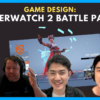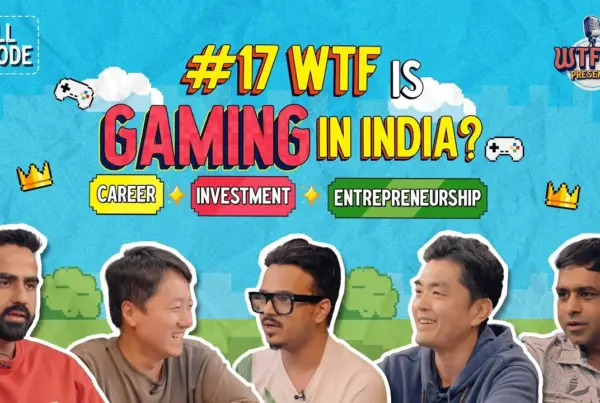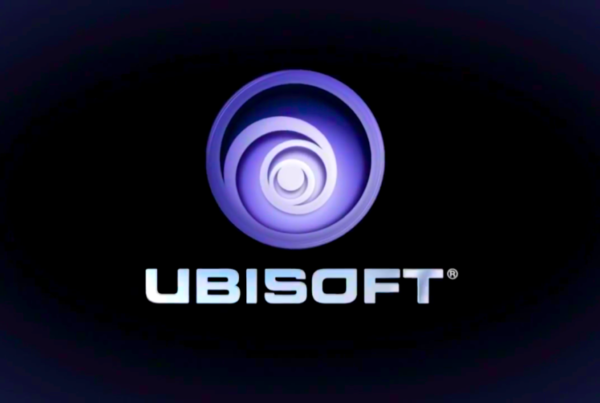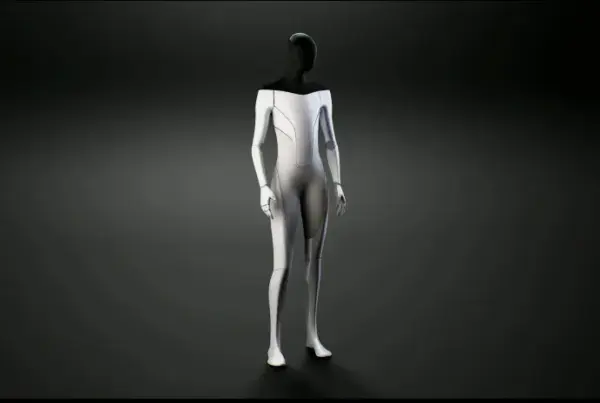he Battle Pass has become one of the most critical monetization and retention tools in free-to-play games, generating an estimated 30-60% of revenue for many shooter titles. Yet, designing an effective Battle Pass involves numerous strategic decisions that directly impact player satisfaction, engagement, and monetization.
🎧 Listen on Spotify, Apple Podcasts, or Anchor ← Subscribe now!
📺 Subscribe to GameMakers on YouTube
Speakers:
- Chris Cobb. Co-founder and CTO at Pragma.gg
- Joseph Kim. CEO at Lila Games.
- Ted Park. Indie Game Developer.
Key Battle Pass Considerations for 2024
Player Choice vs. Production Reality
Overwatch 2, like many hero-based games, faces a fundamental challenge: players have “mains” (favorite heroes) and want cosmetics specifically for these characters. Yet, a Battle Pass cannot realistically include content for every hero.
Ted Park’s analysis of Overwatch 2’s Season 13 Battle Pass revealed that:
- 70% of featured heroes had lower pick rates (bottom 50%)
- Players often feel disappointed when their mains aren’t featured
- The linear unlock structure compounds this issue by forcing players to earn content they don’t value
Chris Cobb noted that this creates tension for studios: “It’s a real challenging thing because you’re going to spend approximately the same amount of time, money, and resources generating content. And there’s always the debate of, do we just keep doubling down on the most popular stuff, or do we try to spread that out?”
Battle Pass Structure Evolution
The Battle Pass has evolved significantly since its inception:
- Original Model: Linear progression tracks where players unlock content sequentially
- Page-Based Systems: As seen in Fortnite, allowing players to choose which items to unlock within pages
- Multi-Track Systems: Like Valorant’s agent-specific unlock tracks
- Currency Systems: Marvel Rivals uses a currency-based system where progression unlocks currency that players spend on preferred items
Chris Cobb shared an interesting historical perspective: “Battle passes started in the mobile space and were known as ‘annuities’… it was just that you would pay five or ten dollars for a 30-day pass and get premium currency at a dripped rate every day.”
The “Golden Ratio” of Time vs. Money
A critical balance exists between how much time players spend versus how much money they pay:
- Too Grindy: If players must invest excessive time (like Star Wars Battlefront 2’s infamous 40-hour grind for content worth $10-20), they feel the system is unfair
- Too Generous: If progress is too quick, players complete the pass rapidly and lose engagement
Chris suggested: “Numbers around a dollar per hour… is a number that makes good sense. Players feel like, okay, if I can earn about a pack an hour… that’s pretty compelling.”
Improving Player Experience
Several innovative approaches are emerging to improve Battle Pass satisfaction:
- Premium Currency Distribution:
- Fortnite includes enough premium currency to purchase the next Battle Pass
- Overwatch 2 provides enough premium currency between free and premium tracks to cover most of the next pass
- Mythic Prisms System:
- Overwatch 2 has evolved to distribute “Mystic Prisms” throughout the Battle Pass
- Players can choose which Mythic items to unlock and upgrade
- This addresses the hero-specificity problem by giving players choice
- Catch-Up Mechanics:
- Battle Pass duration significantly impacts late-joining players
- XP boosts may be more effective than level skips
- Chris noted: “I’ve never found skips to be a very compelling offer… I’ve always questioned that approach.”
Strategic Implications for Developers
Balancing Content Types
Battle Pass value often hinges on the ratio between premium content and filler items:
- Ted observed that while Overwatch 2’s Battle Pass offers “$168 worth of content” for $10, much of it consists of name cards and player icons rarely seen in-game
- More valuable items like victory poses, skins, and weapon charms create stronger perceived value
The experts suggested several approaches to improve this balance:
- Front-loading vs. End-loading Premium Content:
- Front-loading encourages purchases but may reduce engagement
- End-loading drives engagement but may discourage initial purchases
- A hybrid approach with quality items at both ends may be optimal
- Allow Content “Dusting”:
- Let players convert unwanted items into currency
- Ted suggested: “If you don’t like a reward because it’s not for your hero… potentially you could trade that in for currency.”
- Personalized Battle Passes:
- Ted proposed algorithmically generated passes based on player preferences
- Similar to “For You” store sections but applied to progression tracks
The Return of Loot Boxes?
Interestingly, Overwatch 2 is reintroducing loot boxes as Battle Pass rewards:
- Players seem excited about their return despite previous controversies
- They add unpredictability and excitement to the reward structure
- Ted noted: “With the Battle Pass… when you’re able to see the rewards… it’s a little less compelling.”
Chris cautioned: “Where things really get off rails is when you start selling power,” but acknowledged the excitement generated by surprise mechanics when limited to cosmetics.
Final Thoughts: The Future of Battle Pass Design
As Battle Pass systems continue to evolve, developers face complex decisions about structure, value, and player choice. The most successful approaches will likely:
- Provide meaningful player choice without overburdening production teams
- Balance the time-to-value ratio to feel fair but engaging
- Include catch-up mechanics that don’t undermine the engagement value
- Create universal appeal through premium currency or flexible rewards

📝 Battle Pass Design Notes: Shooter Game Comparison
1. BP Design Considerations

2. BP Structure & Pricing
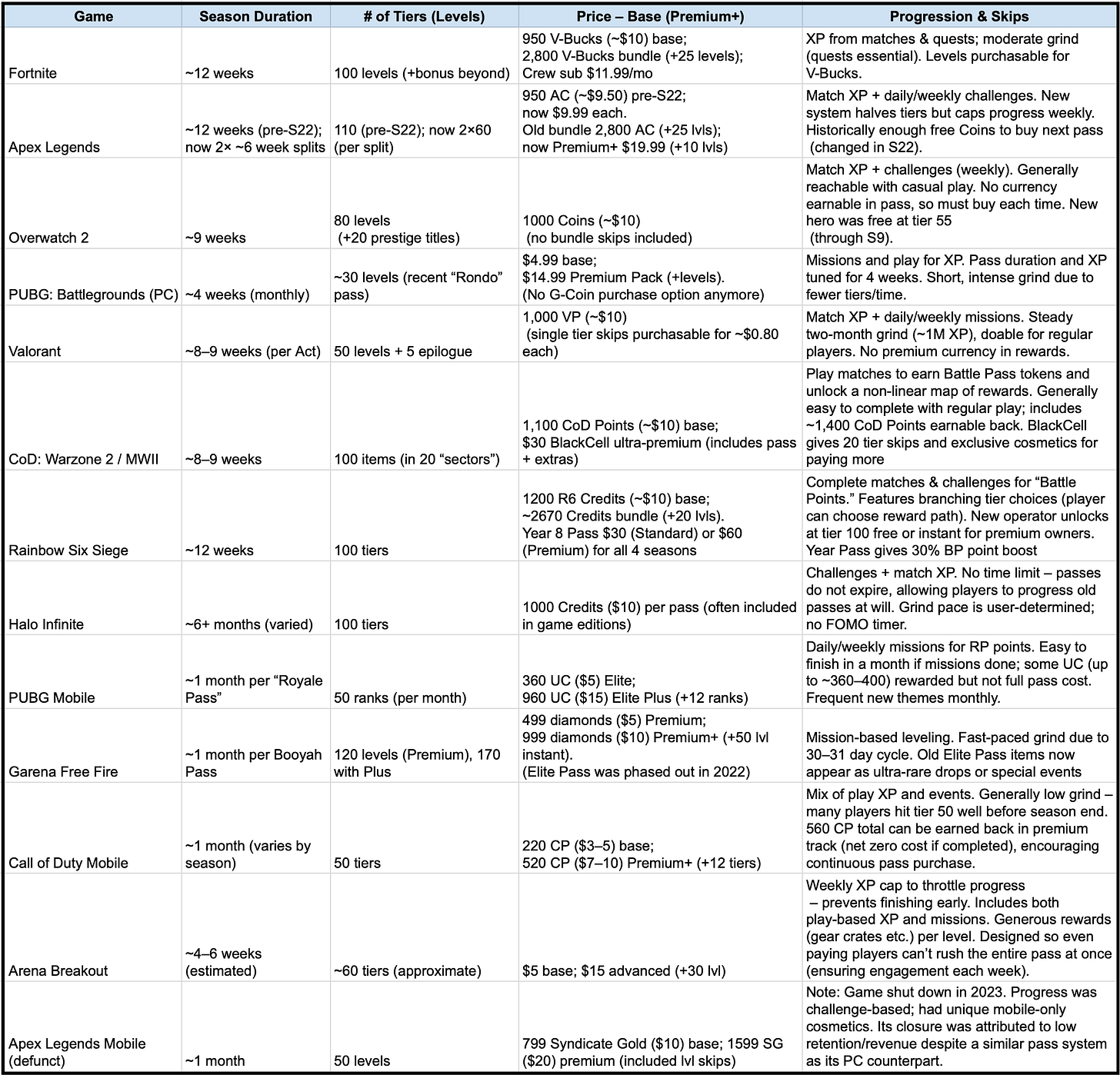
3. BP Notable Differentiators
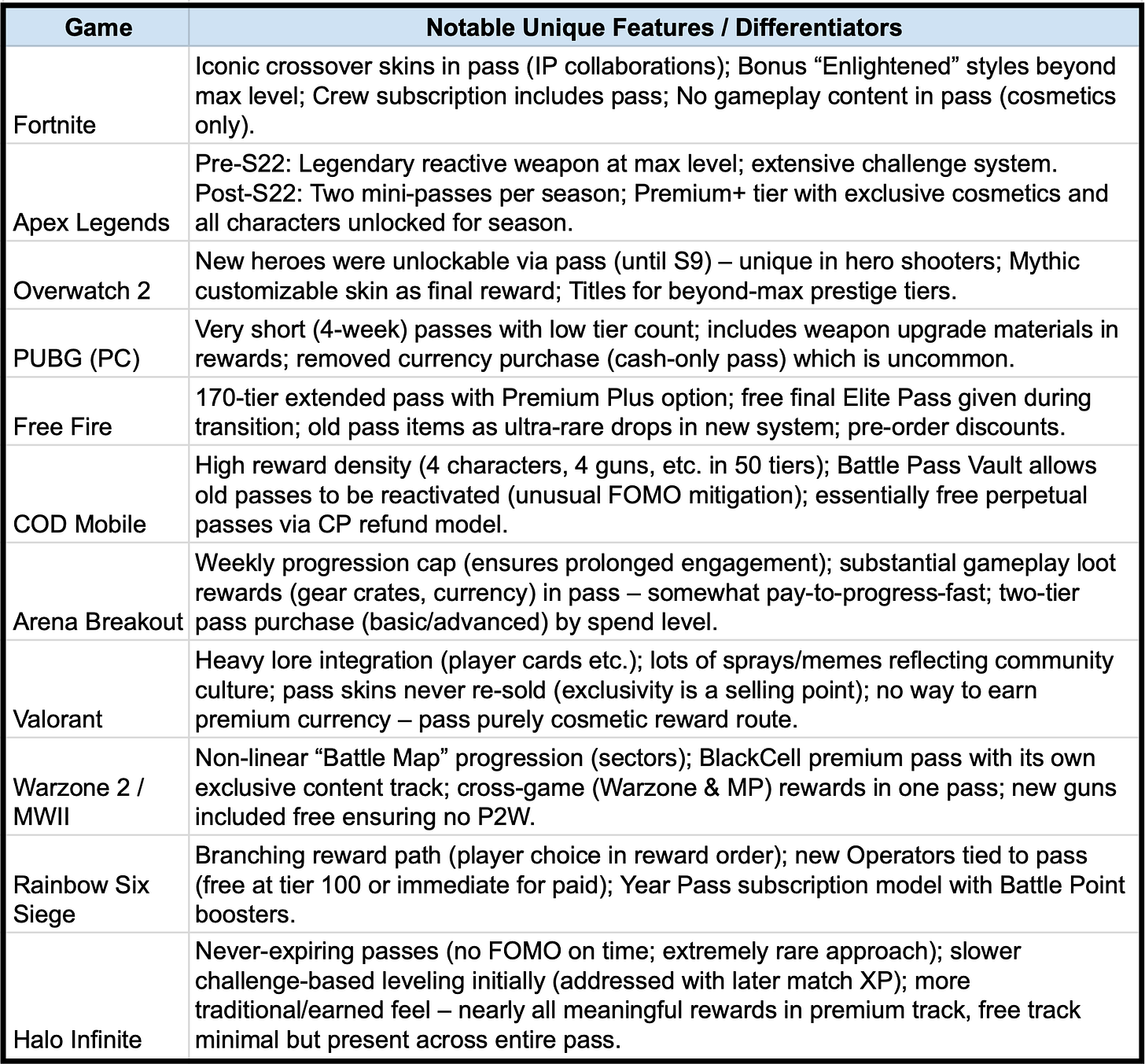
4. BP Games with More than Just Free & Premium Tracks
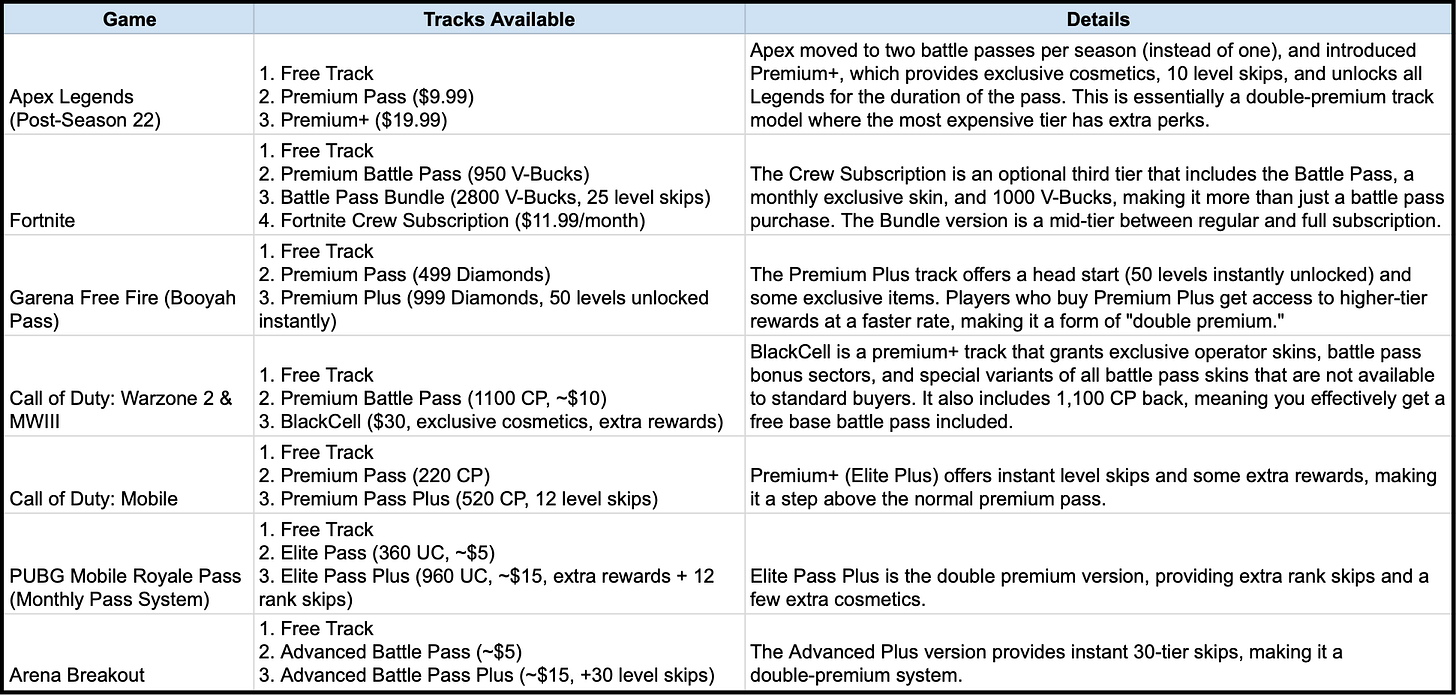
These games only have a Free and Premium track, without a higher Premium+ tier:
- Overwatch 2 (Free + Premium for 1000 Coins, no upgrade option)
- PUBG: Battlegrounds (PC) (Survivor Pass has only two tracks)
- Valorant (Free + Premium for 1000 VP, no tier skips or Premium+)
- Rainbow Six Siege (Free + Premium, but with Year Pass option bundling all seasons)
- Halo Infinite (Free + Premium, no tier skips by default)
5. BP XP Progression
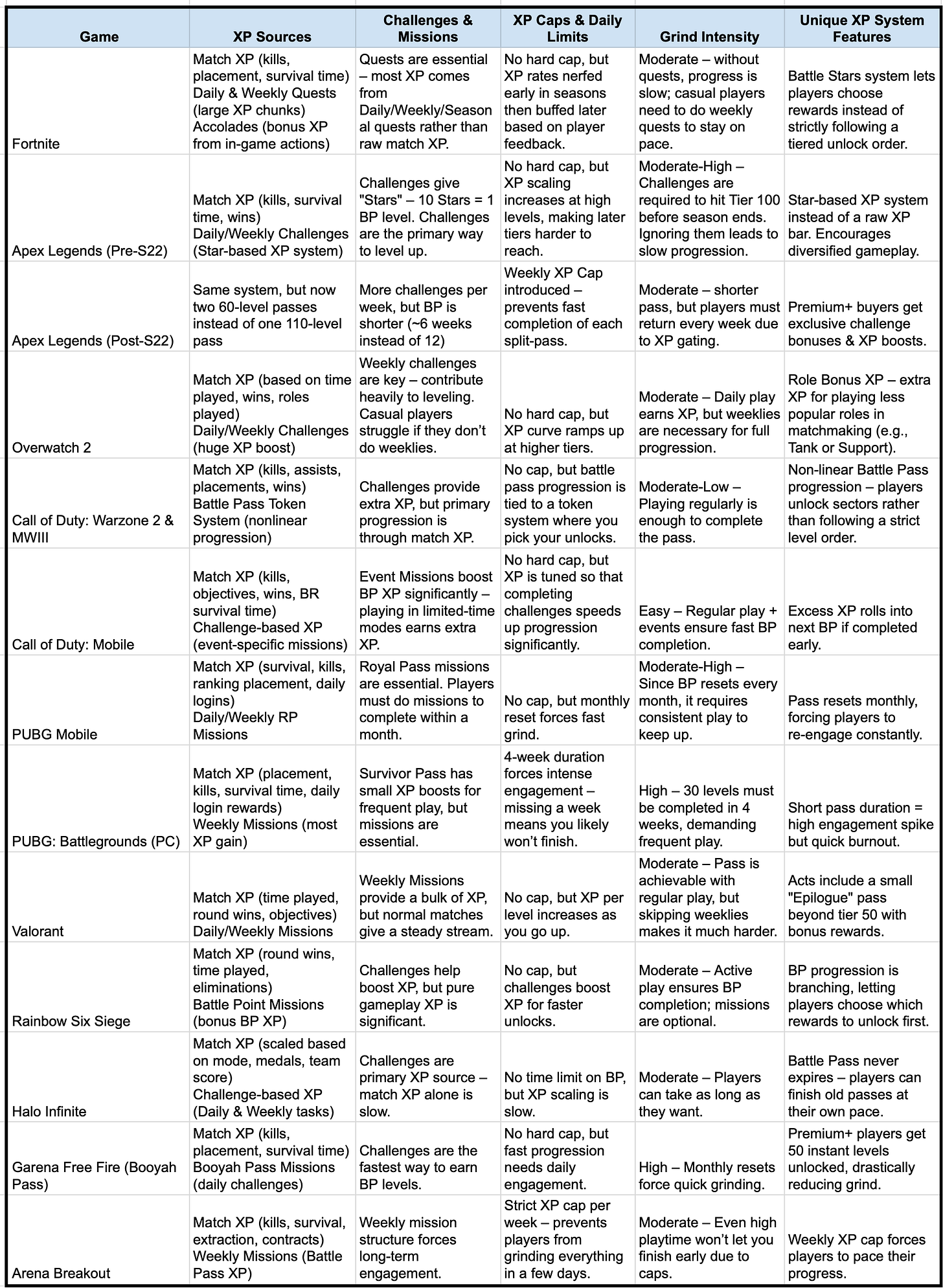
6. BP Customization

7. Community Feedback
- Fortnite: Generally favorable. Fortnite’s community often praises the Battle Pass as a fair system – ~$10 for a trove of skins, with the ability to earn back V-Bucks. Many note that if you only spend on the pass and complete it, you never have to spend real money again (since 950 V-Bucks out, 1500 V-Bucks in). This has built goodwill. Complaints arise if Epic tweaks XP such that leveling becomes harder – e.g., at the start of a new chapter when XP rates were low, Reddit and Twitter exploded until Epic buffed XP gains. Once adjusted, most find it reasonable to complete the pass without no-life grinding. Another point of occasional criticism is content quality: some seasons’ skins or tier-100 rewards are seen as weaker, but others (with big collaborations like Marvel or Star Wars) are highly praised. Overall, Fortnite’s pass is very player-friendly and has set the gold standard against which others are judged.
- Apex Legends: Before the recent changes, Apex’s battle pass was relatively well-received as well – it provided enough coins for the next pass, and while some seasons had lackluster cosmetics (there were memes about “holo sprays” nobody wants taking up slots), the inclusion of unique skins and a flashy reactive weapon each time gave players incentive. The grind was typically viewed as manageable especially if you focused challenges; casual players sometimes complained it was too challenge-dependent (e.g. forcing you to play specific legends or modes to earn stars). Respawn often responded by adjusting challenge difficulty. The Season 22 overhaul has, however, been met with significant backlash. Fans on forums and social media have slammed the move to two $10 passes as pure greed – “charging players twice” for what used to cost the same once. The fact that you can no longer buy it with saved Apex Coins especially drew ire: “the Apex community has not taken too kindly to the news, claiming the decision is fueled by greed”. Many pointed out that a lot of players don’t have time to complete two passes, so they’ll be paying more for potentially less. The reception is decidedly negative, with some vowing not to buy both. It remains to be seen if this will materially hurt player numbers or revenue, but it’s a case where a battle pass change created a PR issue.
- Overwatch 2: Mixed but improving. When OW2 launched F2P with a battle pass, many Overwatch veterans were skeptical (having come from a loot box system that, for all its faults, allowed all skins to be earned free eventually). The biggest controversy was locking new heroes in the free pass – some cried that it was unfair in a competitive game to lock heroes at tier 55 (which could take weeks for a casual player). Blizzard’s defense was that heroes are not immediately needed for competitive and can be unlocked later; they also offered a premium instant unlock. Over time, as mentioned, they decided to give new heroes free to everyone starting in 2024, indicating they listened to feedback. Regarding the pass content, many players feel $10 for 80 tiers (including a Mythic skin) is decent value – especially compared to Overwatch’s overpriced shop skins ($19 for a legendary). The community did complain in Season 1–2 that not enough Credits were given to earn old skins; Blizzard responded by adding Credits to the free pass so players could buy at least a couple old legacy skins each season without paying. Grind-wise, Overwatch 2’s pass is considered fairly easy – streamers noted you could finish by playing maybe an hour or two a day and doing weeklies. Some extremely casual players still don’t finish and feel a bit left out. In general, Overwatch’s battle pass has gone from a major worry (due to hero gating) to a relatively accepted part of the game, especially now that it focuses on cosmetics. Complaints persist about monetization as a whole (e.g. shop prices, lack of free loot), but the battle pass itself is seen as one of the more reasonable parts of OW2’s economy.
- PUBG (PC): PUBG’s passes (Survivor Passes) were moderately popular when the game went F2P, as a way to get skins in a game that historically had only crate/cosmetic key systems. Community perception took a hit with the recent change that you can’t buy passes with G-Coin (the earned currency) anymore. Prior to that, like others, PUBG would give enough G-Coin in a pass to roll over. Now, requiring cash (albeit only $5) is seen as a bit of a cash grab by some long-term players. On the flip side, the price drop to $5 and shorter duration means even working adults might find it easier to complete and justify. The community is somewhat split – some enjoy the fresh monthly content, others lament that it’s too fast (harder to complete every single pass if you take a break at all) and that cosmetics are less exciting. PUBG’s playerbase on PC is smaller now, and a lot of revenue focus is on PUBG Mobile, so the PC pass doesn’t generate as much discussion as it used to. Overall, PC players see it as okay but not as great value as, say, Fortnite’s or Apex’s was.
- Garena Free Fire: The Free Fire community was actually shocked when Garena announced retiring the long-running Elite Pass. Many had nostalgia for seasons of grinding Elite Passes, and some feared Booyah Pass might be worse. Initially, rumors said Booyah Pass might cost more. When it launched at a similar price point and with even more rewards, reception was positive – players enjoyed the refreshed format and better reward variety (gun skins, gloo wall, pet skins, etc., in one pass). The fact that the final Elite Pass was given free in FF Max (India) was seen as a generous farewell. However, because Free Fire has a wide demographic (including younger players), some do find it hard to pay every month even $5, especially in regions where that is relatively costly. Garena often provides local price adjustments and even free pass giveaways in events to keep goodwill – for example, in some servers you can win a free Premium Pass through lucky draws or by grinding tokens. This indicates they manage community sentiment actively, aware that making passes accessible keeps players loyal. The main complaint you’ll hear is about return of old items – veteran players don’t want their rare Elite Pass skins given to newer players, while new players want a chance at them. Garena is trying to satisfy both by making returns extremely limited (Hall of Elites event), thus keeping rarity intact. All in all, Free Fire’s passes are seen as a must-buy for regulars due to their value, and those who can’t buy often express FOMO or hope for giveaways.
- Call of Duty Mobile: The CoD Mobile community widely regards its battle pass as one of the best deals in the game. At just a few dollars (or even free if you saved CP), you get multiple operators and guns – content that in the mainline Call of Duty games would be either not available or sold at much higher prices. Players frequently advise newcomers to buy the pass because of the value. There’s very little negativity about the pass itself. If anything, players might joke that the Battle Pass skins are sometimes better than the store skins. Since the pass is so established, criticism is more directed at other monetization (like lucky draw odds or legendary weapons costing $100+). CoDM’s pass is often held up as “F2P friendly” since you can keep re-buying it with earned CP. As long as TiMi (developer) maintains that model, community sentiment stays positive. Only if they ever removed the CP refund (like Apex did) would there likely be backlash. But seeing as CoDM’s pass is a big reason people log in daily, it’s unlikely they’ll rock that boat.
- Arena Breakout: As a newer title, its community is smaller, but early feedback on the battle pass indicates players find the rewards valuable (because of the gear and goodies). The weekly cap has been debated: some appreciate the fair playing field it creates (no one can whale or no-life to the end immediately), others feel it’s “unnecessary gating” of non-gameplay content. A comment in the community questioned why, if pass rewards are mainly cosmetic, should there be a forced slow rollout– implying some frustration that paying for a pass doesn’t let you grind it at your own pace. The developer’s stance is it protects players’ “long term enjoyment” by stretching out content. This is a distinctive design choice that hardcore players might chafe at, but more casual players likely don’t notice. Given the pass also ties into the game’s economy by giving gear, most players seem to buy it for the utility and view it as worth it. We haven’t seen large outrage regarding monetization in Arena Breakout yet, aside from normal P2W concerns about any game that sells power. The battle pass, in providing a steady drip of gear, might actually alleviate some P2W concerns (since anyone who buys it gets geared up, not just RNG from loot boxes).
- Valorant: Valorant players typically have a favorable view of the battle pass as the budget way to get skins. There are countless threads of players showing off their pass skins or saying “this pass is fire” if they like the cosmetic theme. Occasionally, a pass is deemed underwhelming (e.g. too many meme skins or not as attractive designs), which might reduce purchases that Act. But generally, at $10, even if one likes just one skin line or the melee, it’s worth it. The main community “complaint” is often requests for minor improvements, like maybe adding a small amount of premium currency or more Radianite. But Riot’s stance has been consistent: pass is for content, not premium currency. Compared to spending ~$70 for a bundle of 4 fancy skins in the shop, the battle pass is seen as new-player friendly and a way for free players to grind some customization. Many content creators even rank the best/worst battle passes to help players decide to buy. Since the rewards don’t affect gameplay and are reasonably attainable, there’s little controversy.
- Warzone/Call of Duty (console/PC): The Warzone community mostly accepted the battle pass from MW2019 through Warzone 1 as a standard part of the ecosystem, especially as it delivered functional content like new guns (which were always in the free track so as not to be P2W). The new Sector system in Warzone 2 (MWII) initially confused some, but players got used to it and appreciated the flexibility to choose reward order. The introduction of BlackCell at $30 raised some eyebrows – even hardcore CoD fans felt it was a steep ask on top of a $70 game or for a F2P Warzone player. However, Activision smartly did not remove the cheaper option, so it came off as an optional high-end purchase. Some in the community jokingly call BlackCell buyers “whales” or CoD’s favorite customers, but it didn’t trigger widespread anger because the base pass value remained good (especially with the cross-progression and refund of CoD points). In fact, for Season 3, some actually praised BlackCell’s offerings (exclusive operator and variants) as tempting. It likely saw decent uptake among dedicated players. The consensus remains that the base battle pass is worth it for anyone who plays Warzone/MWII regularly, and BlackCell is there for enthusiasts – a two-tier monetization that didn’t cannibalize goodwill since it wasn’t forced.
Discover more from Joseph Kim
Subscribe to get the latest posts sent to your email.

